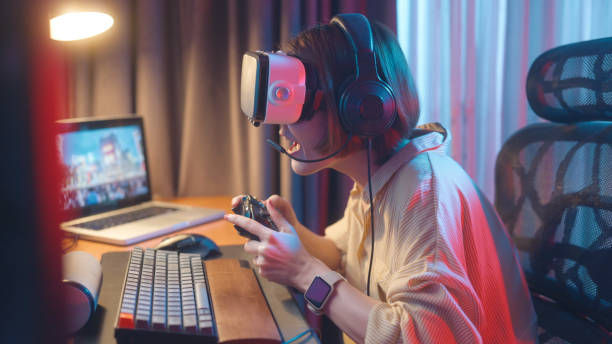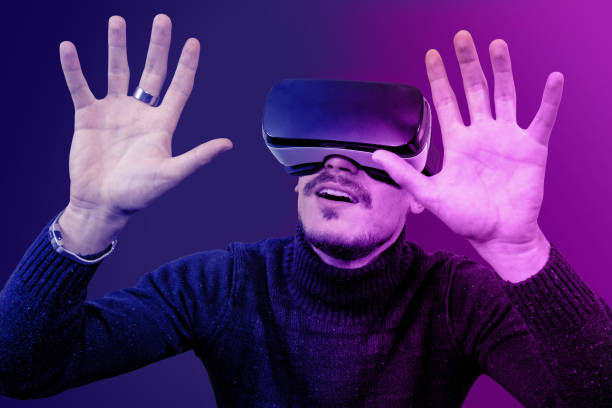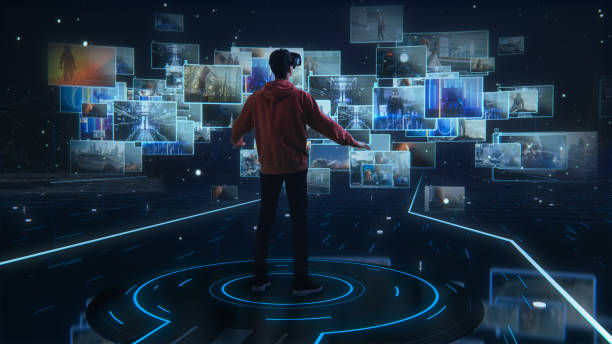Virtual Reality and Storytelling: Enhancing Narrative Experience in Film, TV, and Gaming.
- The Moolah Team
- Jul 10, 2023
- 8 min read
This post will explore the ways VR is being used to enhance narrative experience in film, TV, and gaming, including the potential for VR to create immersive and interactive stories, and to revolutionize the entertainment industry.
I. Introduction: Virtual Reality and Storytelling in Entertainment
Virtual reality (VR) has been making waves in the entertainment industry, particularly in film, TV, and gaming. As an immersive technology, it has the potential to enhance the narrative experience and provide new avenues for storytelling.
A. Definition of virtual reality
VR is a technology that allows users to be fully immersed in a simulated environment that feels and looks like the real world. This is achieved through the use of specialized equipment such as headsets, controllers, and sensors. VR can create a variety of experiences, from gaming to education to therapy.
B. Importance of storytelling in entertainment
Storytelling has always been an integral part of entertainment, from the earliest forms of theatre to the modern day blockbusters. Narratives help us connect with the characters, feel empathy, and understand the world in a more nuanced way. Good stories stay with us long after we've finished experiencing them, and they can shape our perspectives and even influence our behavior.
C. Potential of virtual reality to enhance storytelling
VR has the potential to revolutionize storytelling by providing a more immersive and interactive experience. It allows the audience to become part of the story, rather than just watching it from the outside. With VR, the user can move around, interact with objects and characters, and make decisions that affect the outcome of the story. This creates a more personalized and engaging experience, and can help to deepen the emotional connection between the user and the story.
In the next sections, we will explore how VR is being used in film, TV, and gaming to enhance the narrative experience, as well as its potential to revolutionize the entertainment industry.

II. Virtual Reality in Film: Enhancing Narrative Experience
A. Examples of VR in film
Virtual reality has been used in a variety of ways in film, from creating immersive experiences to enhancing traditional narratives. One notable example is the VR experience created for the film "The Lion King" (2019). The experience allows users to explore the African savanna and interact with characters from the movie. Another example is the VR experience created for the film "Blade Runner 2049" (2017), which allows users to explore the dystopian world of the movie.
B. Benefits and limitations of VR in film
One of the main benefits of using VR in film is the ability to create a more immersive experience for the audience. By placing the viewer in the middle of the action, VR can create a stronger emotional connection between the viewer and the story. However, there are also limitations to using VR in film. One of the biggest challenges is the cost and accessibility of the technology. Creating a VR experience for a film requires a significant investment in equipment, software, and personnel. Additionally, not all audiences may have access to the necessary technology to fully experience the VR component of a film.
C. Future potential of VR in film
Despite the challenges, VR has the potential to revolutionize the way films are made and experienced. As the technology becomes more accessible and affordable, we may see more filmmakers experimenting with VR as a way to tell their stories. Additionally, VR could provide new opportunities for interactive storytelling, allowing users to make choices that affect the outcome of the story. The future of VR in film is an exciting prospect that has the potential to enhance the art of storytelling in new and innovative ways.

III. Virtual Reality in TV: Bringing Stories to Life
A. Examples of VR in TV
Virtual reality has also been used in television to create immersive experiences for viewers. One example is the VR experience created for the series "Westworld" (2016-), which allows users to explore the world of the show and interact with characters. Another example is the VR experience created for the series "Stranger Things" (2016-), which takes users into the Upside Down.
B. Benefits and limitations of VR in TV
Using VR in TV can create a more immersive experience for viewers, allowing them to feel like they are part of the story. This can help to deepen the emotional connection between the viewer and the show. However, there are also limitations to using VR in TV. One challenge is the cost and accessibility of the technology. Not all viewers may have access to the necessary equipment to experience the VR component of a show. Additionally, using VR may not be suitable for all types of TV shows, as it could potentially distract from the narrative.
C. Future potential of VR in TV
Despite the challenges, VR has the potential to revolutionize the way TV shows are made and experienced. As the technology becomes more accessible and affordable, we may see more TV shows incorporating VR as a way to enhance the storytelling experience. Additionally, VR could provide new opportunities for interactive storytelling in TV, allowing viewers to make choices that affect the outcome of the show. The future of VR in TV is an exciting prospect that could help to bring stories to life in new and innovative ways.

IV. Virtual Reality in Gaming: Creating Immersive Worlds
A. Examples of VR in Gaming
Virtual reality has had a significant impact on the gaming industry, with many developers incorporating VR into their games. One example is "Beat Saber" (2018), a VR game that combines music and swordplay. Another example is "Half-Life: Alyx" (2020), a VR game that takes place in the world of the "Half-Life" franchise.
B. Benefits and limitations of VR in Gaming
One of the biggest benefits of VR in gaming is the level of immersion it provides. Players can feel like they are truly in the game world, which can enhance the overall gaming experience. Additionally, VR can provide new opportunities for gameplay and interaction with the game world. However, there are also limitations to using VR in gaming. One challenge is the cost of the technology, which can make it difficult for some players to access. Additionally, VR games may not be suitable for all players, as some may experience discomfort or motion sickness while playing.
C. Future potential of VR in Gaming
As the technology behind VR continues to improve, the potential for VR in gaming is enormous. We may see more games incorporating VR as a way to create even more immersive experiences for players. Additionally, VR could provide new opportunities for multiplayer gaming, allowing players to interact with each other in a more realistic way. The future of VR in gaming is an exciting prospect that could lead to new and innovative gameplay experiences.

V. Challenges and Opportunities for VR Storytelling
A. Technical Challenges
One of the biggest challenges in creating VR stories is the technical requirements. In order to create a truly immersive experience, the hardware and software must work seamlessly together. This requires a high level of technical expertise, as well as access to expensive equipment. Additionally, VR experiences must be optimized for different hardware platforms, which can be a complex and time-consuming process.
B. Narrative Challenges
Another challenge of VR storytelling is creating a narrative that is compelling and interactive. Traditional storytelling techniques may not work in a VR environment, as the audience has more agency and control over their experience. Storytellers must find ways to engage the audience while still allowing for exploration and interaction within the story world. Additionally, creating believable and engaging characters in VR can be a challenge, as traditional character development techniques may not be as effective in a 360-degree environment.
C. Opportunities for Innovation
Despite the challenges, VR storytelling presents exciting opportunities for innovation in storytelling. With the ability to create fully immersive environments and interactive experiences, storytellers can engage audiences in new and exciting ways. Additionally, VR storytelling allows for new levels of emotional engagement, as audiences can experience the story world in a more personal and visceral way. Finally, VR storytelling can open up new possibilities for interactivity and audience participation, as audiences can shape the story in real-time.
D. Integrating VR with Traditional Storytelling
While VR storytelling presents unique opportunities, it is important to note that it can also be used in conjunction with traditional storytelling techniques. For example, VR could be used to create immersive prequels or sequels to traditional films or television shows. Alternatively, VR experiences could be used to enhance the world-building and backstory of a traditional story world. The integration of VR with traditional storytelling could provide new ways for audiences to engage with their favourite stories, while still preserving the core elements of traditional storytelling.
E. The Future of VR Storytelling
As the technology behind VR continues to improve and become more accessible, the potential for VR storytelling is enormous. We may see more filmmakers, television producers, and game developers incorporating VR into their projects as a way to create more immersive and interactive experiences for audiences. Additionally, as audiences become more comfortable with VR technology, we may see an increase in demand for VR storytelling experiences. The future of VR storytelling is an exciting and dynamic prospect that will continue to evolve and change as technology advances.

VI. Conclusion: The Future of VR Storytelling
In conclusion, virtual reality technology has the potential to revolutionize the entertainment industry by enhancing narrative experience in film, TV, and gaming. VR can create immersive and interactive stories that allow audiences to experience the story world in a more personal and visceral way. While there are technical and narrative challenges to overcome, the opportunities for innovation and creativity are endless.
One of the most exciting aspects of VR storytelling is its potential to create empathy and emotional connection with audiences. By immersing audiences in the story world, VR can create a deeper level of emotional engagement than traditional storytelling. This has implications not only for entertainment but also for education and social change. VR can be used to create powerful experiences that allow audiences to empathize with different perspectives and experiences, fostering greater understanding and compassion.
As VR technology continues to improve and become more accessible, we may see an increase in demand for VR storytelling experiences. This presents an opportunity for filmmakers, television producers, and game developers to create new and exciting content that engages audiences in new and innovative ways. Additionally, the integration of VR with traditional storytelling techniques opens up new possibilities for world-building and audience engagement.
In order to fully realize the potential of VR storytelling, it will be important to continue to develop the technology and techniques that make it possible. This includes improving hardware and software, as well as developing new narrative techniques that take advantage of the unique affordances of VR. Additionally, it will be important to ensure that VR experiences are accessible and inclusive, so that everyone can have the opportunity to engage with this new form of storytelling.
Overall, the future of VR storytelling is an exciting and dynamic prospect that will continue to evolve and change as technology advances. We can expect to see more immersive and interactive experiences that push the boundaries of storytelling and engage audiences in new and exciting ways. As VR technology becomes more widely available, we can look forward to a future where storytelling is more engaging, more immersive, and more powerful than ever before.
Thank you for taking the time to read our post on Virtual Reality and Storytelling. We hope you found it informative and engaging. If you enjoyed this post and want to stay up-to-date on the latest developments in VR and storytelling, be sure to subscribe to our newsletter.
At Moolah, we're passionate about exploring new and innovative ways to enhance the storytelling experience. By harnessing the power of technology, we can create immersive and engaging narratives that transport audiences to new worlds and challenge our perceptions of what is possible.
Once again, thank you for reading, and we look forward to bringing you more exciting content in the future.
Moolah







Comments